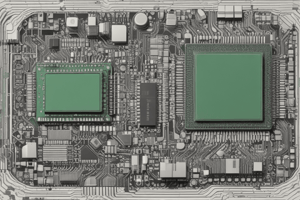Podcast
Questions and Answers
What is the maximum frequency at which the 8085 microprocessor can operate?
What is the maximum frequency at which the 8085 microprocessor can operate?
- 5 MHz
- 1 MHz
- 2 MHz
- 3 MHz (correct)
What kind of instructions does the 8085 microprocessor's ALU perform?
What kind of instructions does the 8085 microprocessor's ALU perform?
- 16-bit operations
- 8-bit operations (correct)
- 32-bit operations
- 64-bit operations
Which of these signals indicates that data is to be written into a memory location?
Which of these signals indicates that data is to be written into a memory location?
- ALE
- INTR
- RD
- WR (correct)
How many maskable interrupts does the 8085 microprocessor have?
How many maskable interrupts does the 8085 microprocessor have?
What type of bus carries the unique binary pattern used to identify a memory location?
What type of bus carries the unique binary pattern used to identify a memory location?
What does the data bus transfer between the memory and processor?
What does the data bus transfer between the memory and processor?
In the instruction format of the 8085 microprocessor, what does the opcode represent?
In the instruction format of the 8085 microprocessor, what does the opcode represent?
Which addressing mode uses data provided directly in the instruction?
Which addressing mode uses data provided directly in the instruction?
What is the characteristic of a Three-Byte Instruction in the 8085 microprocessor?
What is the characteristic of a Three-Byte Instruction in the 8085 microprocessor?
What does the MOV A, [] instruction exemplify in terms of addressing mode?
What does the MOV A, [] instruction exemplify in terms of addressing mode?
Study Notes
8085 Microprocessor Overview
- The 8085 microprocessor uses an 8-bit data bus and a 16-bit address bus.
- This allows for 64KB of addressable memory.
- Operates at a maximum frequency of 3 MHz.
8085 Microprocessor Control Signals
- RD (Read): Active low signal. Indicates data is available on the data bus for reading.
- WR (Write): Active low signal. Indicates data on the data bus should be written to a selected memory or I/O location.
- ALE (Address Latch Enable): Positive going pulse. Indicates that the bits on AD7-AD0 are address bits.
8085 Microprocessor Status Signals
- IO/M: Differentiates between I/O and Memory operations. High for I/O, low for Memory.
- S1 and So: Status signals that can identify various operations but are rarely used.
8085 Microprocessor Interrupts
- Supports three maskable interrupts (RST 7.5, RST 6.5, RST 5.5).
- One non-maskable interrupt (TRAP).
- One externally serviced interrupt (INTR).
8085 Microprocessor Data Transfer Operations
- Memory Read: Reads data or instructions from memory.
- Memory Write: Writes data or instructions into memory.
- I/O Read: Receives data from an input device.
- I/O Write: Sends data to an output device.
8085 Microprocessor Instruction Structure
- Instructions are commands to the microprocessor to perform a specific task.
- Each instruction consists of an opcode (operation code) and an operand (data to be operated on).
- Instruction types are categorized by word size:
- One-Byte Instructions: Opcode and operand in the same byte.
- Two-Byte Instructions: Opcode in the first byte, operand in the second.
- Three-Byte Instructions: Opcode in the first byte, 16-bit address in the next two bytes.
8085 Microprocessor Addressing Modes
- Immediate Addressing: Operands provided directly within the instruction.
- Register Addressing: Operands provided through registers.
- Direct Addressing: Accepts data from external devices or sends data to them.
- Indirect Addressing: The processor calculates an effective address and uses its contents to form a second address where data is stored.
- Implicit Addressing: The data itself specifies the data to be operated on.
8085 Microprocessor Instruction Set Categories
- Data Transfer Instructions: Transfer data between registers, memory, and I/O devices.
- Arithmetic Instructions: Perform addition, subtraction, increment, or decrement operations.
- Logical Instructions: Perform logical operations like AND, OR, compare, and rotate.
- Branching Instructions: Control program flow with conditional and unconditional jumps, subroutine calls, and returns.
- Machine Control Instructions: Control machine functions like Halt, Interrupt, or do nothing.
8085 Microprocessor Example Programs
- Multiplying Two 8-bit Numbers:
- Loads immediate data into accumulator (A), registers B and C.
- Loops to add the content of B to the accumulator and decrement C.
- Stores the result in memory location 1000H.
- Finding the Largest Number in an Array:
- Loads the address of the first element of the array into the HL pair.
- Loads the count into register B.
- Sets the first element as the largest data.
- Iteratively compares the current element with the largest found so far.
- Stores the largest value in memory location 2000H.
Direct Memory Access (DMA)
- Enables data transfer between memory and I/O subsystems with limited CPU intervention.
- Provides a faster alternative to Programmed I/O (PIO).
- Requires a DMA controller that can independently access memory.
- The DMA device asserts the processor's bus request signal, and the processor relinquishes the buses.
- The DMA controller then directly transfers data between source and destination.
- The processor resumes control once the DMA operation is complete.
8085 Microprocessor DMA Pins
- HOLD: Active-high input signal. Indicates a DMA request. The 8085 relinquishes the buses.
- HLDA (Hold Acknowledge): Active-high output signal. Indicates that the 8085 has relinquished the buses.
Studying That Suits You
Use AI to generate personalized quizzes and flashcards to suit your learning preferences.
Related Documents
Description
This quiz covers the fundamentals of the 8085 microprocessor, including its architecture, control signals, status signals, and interrupt mechanisms. Test your understanding of memory addressing and the functions of various signals in the 8085 architecture.





